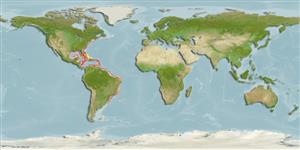Common names from other countries
>
Perciformes/Bembropoidei (Duckbill flatheads) >
Bembropidae (Duckbill flatheads)
Etymology: Bembrops: Greek, bembras, -ados = a kind of anchovy m+ Greek, ops = appearance (Ref. 45335); ocellatus: From the Latin ocellus, little eye, in reference to the black spot on the dorsal base of the caudal fin..
Environment: milieu / climate zone / depth range / distribution range
بوم شناسي
دريايي موجوداتی که در اعماق زیر 200 متر زندگی و تغذیه می کنند; تغييرات عمق 394 - 579 m (Ref. 31109). Deep-water
Western Central Atlantic: Atlantic Ocean off eastern coast of Venezuela and widely distributed in the Caribbean Sea.
Size / Weight / سن
Maturity: Lm ? range ? - ? cm
Max length : 18.8 cm SL جنس نر / بدون خواص جنسي; (Ref. 31109)
Life cycle and mating behavior
بلوغ | تولید مثل | تخم ریزی | تخم ها | Fecundity | توزاد ( لارو)
Thompson, B.A. and R.D. Suttkus, 1998. A review of western north Atlantic species of Bembrops, with descriptions of three new species, and additional comments on two eastern Atlantic species (Pisces: Percophidae). Proc. Biol. Soc. Wash. 111(4):954-985. (Ref. 31109)
وضعيت در فهرست قرمز IUCN (Ref. 130435)
CITES (Ref. 128078)
Not Evaluated
خطر برای انسان ها
Harmless
استفاده انسانی
اطلاعات بيشتر
اسامي عاممترادفسوخت و سازشکارچیانسم شناسي بوم زيستيتولید مثلبلوغتخم ریزیFecundityتخم هانمو تخم
Age/Size
رشد
طول - وزن
طول - طول
نوسانات طولی
ريخت ستجي بوسيله انداره گيري
ريخت شناسي
توزاد ( لارو)
پويايي لاروي
بازسازی
فراواني
مراجعآبزي پرورينمايه آبزي پرورينژادهاژنتيكElectrophoresesوارثبيماري هافرآوریMass conversion
همكارانعکس هاStamps, Coins Misc.صداهاسيگواتراسرعتنوع شناگریمنطقه آبششيOtolithsمغزهابینایی
ابزارها
گزارش های ويژه
بارگيری XML
منابع اينترنتي
Estimates based on models
Preferred temperature (Ref.
115969): 8.5 - 14.8, mean 11.4 (based on 31 cells).
Phylogenetic diversity index (Ref.
82804): PD
50 = 0.5000 [Uniqueness, from 0.5 = low to 2.0 = high].
Bayesian length-weight: a=0.00372 (0.00153 - 0.00904), b=3.10 (2.89 - 3.31), in cm Total Length, based on LWR estimates for this (Sub)family-body shape (Ref.
93245).
Trophic level (Ref.
69278): 4.0 ±0.4 se; based on size and trophs of closest relatives
Fishing Vulnerability (Ref.
59153): Low vulnerability (13 of 100).
